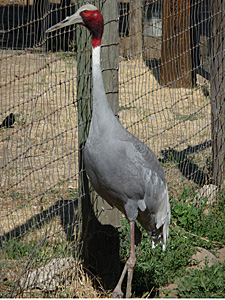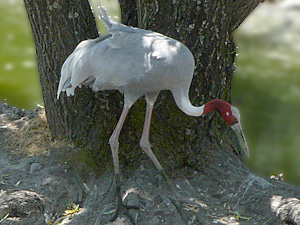
Sarus Cranes
Grus antigone
These are my biggest cousins. In fact, they are reputed to be the tallest of the birds that fly. They can be over six feet tall with an eight foot wing span. They live mostly in India (map of their range), though some also live in southern Asia and as far south as Australia!
The Indian population has adapted to living with humans and is particularly well suited to areas where small patches of wetland are interspersed with well managed farmland. They also do well around rice fields, particularly since much of the natural wetland habitat has been lost. The humans where they live tolerate and even revere them. Their meat is taboo in ancient Hindu scriptures, and due to that famous crane monogamy, they are considered a symbol of marital success.
Interesting Sarus Facts


- Indian Sarus cranes are not migratory. Mating pairs are territorial throughout the year, while non mating birds live together in small groups, called sedges.
- These cousins are definitely turned on by water. Although they MAY breed at any time of year, in India they breed primarily during the monsoon season and in Australia at the onset of the rainy season.
- All my cousins are big communicators. This coz has the usual repertoire of singing and dancing displays. He also can communicate by brightening the color of the reddish skin on the side of his head and neck. He can make his points very vivid!
More Sarus Crane Information

- Population 15-20,000. Classified as vulnerable.
- Primary threat is the degradation of wetlands in India. Due to the many humans who share the land with them, their breeding grounds are damaged by agricultural expansion and runoff, pesticides, and sewage. They also have problems colliding with power lines.
Want to Know More?